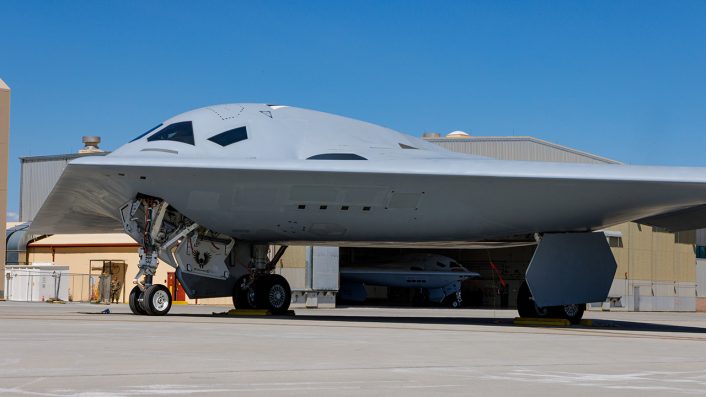Aviation Week reported on a memo by the head of AFGSC that recommends a shift from current plans for two pilots on the B-21 Raider to a pilot and weapon systems officer (WSO) combination.
“Unleashing the Raider’s full potential demands a complex blend of skills: airmanship, weaponeering, electromagnetic spectrum operations, sensor management, real-time battle management and agile replanning in combat. For this reason, the B-21 will be crewed by one pilot and one weapon systems officer.” reads the memo from General Thomas Bussiere, then Commander of Air Force Global Strike Command (AFGSC), as seen by Aviation Week.
Though yet to be formally accepted as official policy by the wider U.S. Air Force administration, the recommendation is a reversal of previous plans for the two-seat B-21 Raider to be flown by two pilots, like the B-2 Spirit. In 2020 plans to allow current WSOs from current B-52 Stratofortress and B-1B Lancer units to retrain as pilots ahead of the B-21’s arrival were announced – it is unclear whether this developed beyond the proposal stage and if any WSOs did undergo such role conversion training.
B-21 news: A solo pilot and WSO? https://t.co/WnkEd5v0KL
— Brian Everstine (@beverstine) November 3, 2025
Both the Stratofortress and the Lancer are usually assigned a pair of WSOs along with a complement of two pilots for each sortie – for the B-52 a fifth seat is used by a electronic warfare officer (EWO), and a sixth ejection seat can accommodate an additional crew member. In such cases, the need for WSOs to be trained in at least basic piloting tasks is limited as if one pilot becomes incapacitated the other is able to continue flying as normal. For the B-21, though, WSOs will almost certainly be required to pilot the aircraft during at least some stages of flight.

On the B-2 it is well known that the aircraft can be flown solo for periods of time, allowing the two pilots to work in shifts during extended sorties and make use of a small ‘rest area’ behind the cockpit seats where there is just enough room for a chemical toilet and a camp bed.
The Air Force is sure to want to keep this practice in place – without it, long range missions with such a limited crew size would become effectively impossible. The longest continuous sortie flown by a B-2 crew notched up over 44 hours of flight time, while the B-2 flights during Operation Midnight Hammer earlier this year lasted around 37 hours.
Inching Closer to Service
The B-21 Raider has been flying regular test sorties for almost two years. In September 2025 the second airworthy test airframe, designated T-2, took flight for the first time. Two further airframes are known to have been completed and are dedicated to ground testing.
Here are photos of the second B-21 Raider test aircraft taking off from Palmdale, Calif., to join the Air Force’s flight test campaign at @EdwardsAFB, today. #B21Raider #AirPower @usairforce I @DeptofWar https://t.co/86CjZwPcuD pic.twitter.com/mVO0lJE0KH
— Office of the Secretary of the Air Force (@SecAFOfficial) September 11, 2025
Ellsworth Air Force Base, South Dakota, is expected to see its first B-21s delivered sometime in the mid 2020s. Whiteman AFB, home of the B-2 Spirit, and Dyess AFB are the other two bases earmarked to host B-21 Raiders. Minot AFB and Barksdale AFB will likely continue operating the B-52 Stratofortress for many years to come as the aircraft prepares for a major upgrade programme that will see re-engined aircraft designated as B-52Js. This upgrade will help to see the venerable aircraft serve through 2050, while the B-1 and B-2 are due to be withdrawn in favor of the B-21.
Smaller than the B-2, the B-21 is expected to make up for a reduced payload with a vastly increased fleet size which, under current plans, will see more B-21s produced than there are active B-1s and B-2s combined. Over 100 B-21s are expected to be supplemented during operations by collaborative combat aircraft (CCAs) which could add to the weapons capacity, sensor range and capability, and survivability of an assembled strike package.

Notably, each B-21 will only be able to carry one of the famous GBU-57 Massive Ordnance Penetrator (MOP) bunker buster bombs per aircraft, compared to two per B-2. This would theoretically mean twice as many bombers would be required to stage a recreation of Operation Midnight Hammer, though the weapon’s replacement – labelled the Next Generation Penetrator (NGP) – is planned to be significantly lighter than the MOP, and might therefore be of a size that again will allow the carriage of multiple bombs.
In contrast to many ongoing procurement processes in motion with armed forces across the globe, the B-21 Raider programme is proceeding not only at a good pace but is frequently coming in at under its expected budget. The U.S. Air Force has not ruled out the development of new variants of the bomber design focused on other missions, even including air to air combat. A B-21, operating in tandem with manned and unmanned aircraft, could carry a massive number of air to air missiles into combat while remaining undetected by radar. With modern datalinks and advanced missile designs, air to air weapons on board a B-21 could be cued and directed by sensor systems on fighter aircraft.









